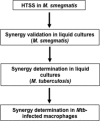Synergistic drug combinations for tuberculosis therapy identified by a novel high-throughput screen
- PMID: 21576426
- PMCID: PMC3147639
- DOI: 10.1128/AAC.00474-11
Synergistic drug combinations for tuberculosis therapy identified by a novel high-throughput screen
Abstract
Therapeutic options for tuberculosis (TB) are limited and notoriously ineffective despite the wide variety of potent antibiotics available for treating other bacterial infections. We investigated an approach that enables an expansion of TB therapeutic strategies by using synergistic combinations of drugs. To achieve this, we devised a high-throughput synergy screen (HTSS) of chemical libraries having known pharmaceutical properties, including thousands that are clinically approved. Spectinomycin was used to test the concept that clinically available antibiotics with limited efficacy against Mycobacterium tuberculosis might be used for TB treatment when coadministered with a synergistic partner compound used as a sensitizer. Screens using Mycobacterium smegmatis revealed many compounds in our libraries that acted synergistically with spectinomycin. Among them, several families of antimicrobial compounds, including macrolides and azoles, were also synergistic against M. tuberculosis in vitro and in a macrophage model of M. tuberculosis infection. Strikingly, each sensitizer identified for synergy with spectinomycin uniquely enhanced the activities of other clinically used antibiotics, revealing a remarkable number of unexplored synergistic drug combinations. HTSS also revealed a novel activity for bromperidol, a butyrophenone used as an antipsychotic drug, which was discovered to be bactericidal and greatly enhanced the activities of several antibiotics and drug combinations against M. tuberculosis. Our results suggest that many compounds in the currently available pharmacopoeia could be readily mobilized for TB treatment, including disease caused by multi- and extensively drug-resistant strains for which there are no effective therapies.
Figures




References
-
- Abbate E., et al. 2007. Extensively resistant tuberculosis (XDR-TB) in Argentina: epidemiology, bacteriology, therapy and outcome. Rev. Argentina Med. Respir. 1:19–25
-
- Abu-Basha E. A., Gehring R., Albwa'neh S. J. 2007. Pharmacokinetics and bioavailability of spectinomycin after i.v., i.m., s.c. and oral administration in broiler chickens. J. Vet. Pharmacol. Ther. 30:139–144 - PubMed
-
- Amaral L., Boeree M. J., Gillespie S. H., Udwadia Z. F., van Soolingen D. 2010. Thioridazine cures extensively drug-resistant tuberculosis (XDR-TB) and the need for global trials is now! Int. J. Antimicrob. Agents 35:524–526 - PubMed
-
- Amaral L., Kristiansen J. E., Viveiros M., Atouguia J. 2001. Activity of phenothiazines against antibiotic-resistant Mycobacterium tuberculosis: a review supporting further studies that may elucidate the potential use of thioridazine as anti-tuberculosis therapy. J. Antimicrob. Chemother. 47:505–511 - PubMed
Publication types
MeSH terms
Substances
Grants and funding
LinkOut - more resources
Full Text Sources
Other Literature Sources
Medical

